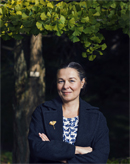Margret Steinthorsdottir

Researcher.
Contact
Phone: +46 (0)8 519 540 04
E-mail: Margret.Steinthorsdottir@nrm.se
Billing and Mailing Address:
Education
B.Sc. University of Copenhagen, Denmark, 2000
M.Sc. University of Copenhagen, Denmark, 2003
Ph.D. University College Dublin, Ireland, 2011
Responsibilities
Research on the role of CO2 in climate variability, and the associated hydrological and ecological changes, using fossil plants. Additional duties at PAL include registering parts of the fossil collections and help running a seminar series. For the last several years, I have taught a variety of courses at the Department of Geological Sciences, Stockholm University. Presently this involves co-leading and teaching a distance course on “Critical Steps in the Evolution of Earth and Life” and a new master's course in Palaeontology.
Research Interests
The overall aim of my research is to utilize past climate change transitions as a “natural laboratory” to understand Earth’s full range of climate variability and to address the current uncertainty regarding the precise role of CO2 in climate change.
I do this firstly by developing new high-resolution CO2 records using fossil plant leaves. I apply the stomatal proxy method, which relies on the inverse relationship between CO2 and the density of stomata on plant leaves to estimate past CO2 and assess the radiative forcing on Earth’s climate.
Secondly, I explore the physiological forcing of CO2 on plant transpiration – a major component of Earth’s hydrological cycle – using fossil plant data in numerical leaf gas-exchange models. Radiative forcing of high pCO2 has been the dominant consideration in research of global climate change, but this may underestimate the effects of rising CO2 on e.g. fresh water availability, flooding and erosion, together with the potential significant consequences for ecosystems.
In project GLOBAL GINKGO, I aim to refine the stomatal proxy by testing the variability of stomatal densities and other parameters of the “living fossil” tree Ginkgo biloba, growing under identical CO2 concentrations, but widely variable climatic conditions, across the globe.
In addition, I am interested in plant-insect interactions and the use of experimental chambers to test plant responses to different atmospheric and temperature conditions.



